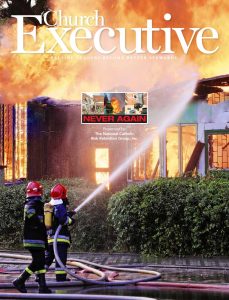
By Crispin Ketelhut
A church decided to hire a coach from the congregation for its intramural sports league’s youth softball team. It conducted an extensive screening process with professional background checks, an application process, reference checks and two face-to-face panel interviews.
 Once hired, the coach was provided with an unmonitored smart phone and left to conduct his coaching and communications as he saw fit. Since his position description encouraged him to use social media to reach out to youth, he immediately began to “friend” the congregation’s teens using his personal social media accounts.
Once hired, the coach was provided with an unmonitored smart phone and left to conduct his coaching and communications as he saw fit. Since his position description encouraged him to use social media to reach out to youth, he immediately began to “friend” the congregation’s teens using his personal social media accounts.
A year after he was hired, Lena, one of the 15-year-old girls on the softball team, was hospitalized for attempted suicide. Her mother reviewed Lena’s cell phone and found dozens of “sexts” and naked images sent between Lena and the coach. She also discovered cyber-harassment from the coach via private messages on Lena’s social media accounts, threatening that he’d anonymously publish Lena’s nude photos for the whole church to see. Lena’s suicide attempt was an extreme coping response to the cyber-harassment and bullying from the coach.
Eventually, Lena’s mother sued the church for negligence, stating it was responsible and subsequently negligent in monitoring its employee and his technology devices — and that Lena’s physical, psychological and emotional trauma was entirely preventable.
“[I]t wasn’t what occurred during the hiring process that put the children and
church at risk; it was what didn’t occur after.”
Didn’t the church do everything possible to prevent the possibility of risk?
Imagine a well-cared for, impenetrable fence designed to keep vermin out of a prosperous, highly visited vineyard — an excellent way to ensure protection from pests. Now envision a gatehouse attached to the fence where guests must go through access-control procedures. However, once inside, near the fruit, there aren’t any rules to stipulate proper behavior.

Comparably, it wasn’t what occurred during the hiring process that put the children and church at risk; it was what didn’t occur after. Even though prior due diligence was performed, rules were never established prescribing conduct and policies weren’t written — nor were acknowledgement receipts signed and kept on file. The coach had sole, unfettered access to the youth via the Internet in intrinsically private electronic communications, without oversight or monitoring.
What should the church have done?
To protect not only the youth within their care, but also its reputation and financial assets, the church should also have established the following policies, including but not limited to:
- A written policy with definitions and parameters to foster accountability, outline specific behavior, delineate ministry timeframes, etc., for each method of communication, including all social networking sites / applications.
- Safe-environment training. Employees / volunteers must be held to the same standard, with training on the reality of abuse, appropriate behavior, expectations, warning signs and communicating concerns. This helps the church take preventative measures in reducing the instances of risk and also be proactive in addressing a problem.
- Checks and balances. Every social media account representing a church ministry needs monitoring to include oversight from multiple, unrelated adults with password access who regularly review messages and content. Under no circumstances should private accounts be used for ministry purposes, and no adult should “friend” or contact individual students from a personal account.
- Permission slips denote what forms of communication are preferred by the parents when communicating with their children.
Hard lesson learned
Churches can’t always prevent bad situations. But, we can at least create a safer environment where, ultimately, risk is lessened because acceptable behavior and expectations are clearly stated, and there’s less opportunity for grooming / bad actions to occur. And if they do occur, we know how to respond because of safe-environment training.
As representatives of church communities, we have a responsibility to protect the vulnerable among us before we can foster ministry. Creating safe environment policies — and following up on them — is an important step in risk control. It’s a whole lot easier to prevent issues than to have to deal with violations and terrible consequences once they occur.
Don’t learn this the hard way; protect your church and congregation before tragedy strikes.
Crispin Ketelhut is the national Associate Director of the VIRTUS Programs, NCS Risk Services, LLC. The VIRTUS Programs are highly recognized in providing educational materials / training for the prevention of child abuse and risk management. For training options and sample policies, visit www.virtus.org



